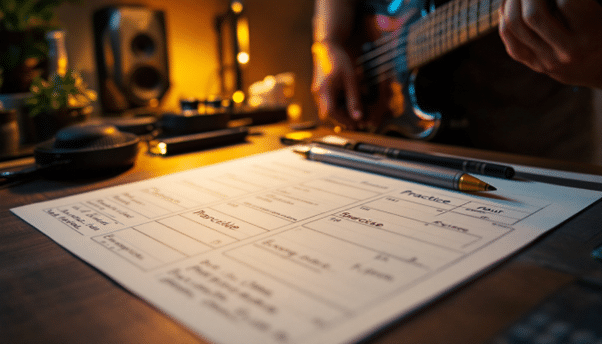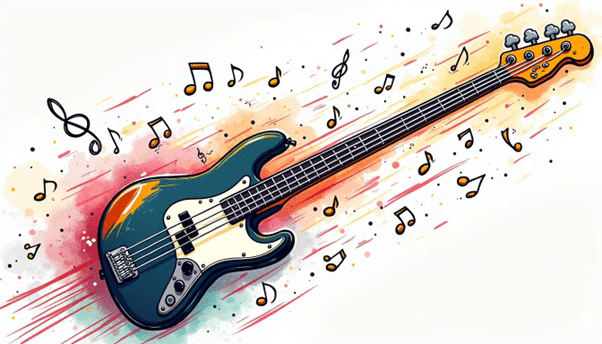Learning the bass guitar can seem daunting at first, but with the right strategies and shortcuts, it can be an enjoyable and rewarding experience. This article aims to provide essential tips and techniques that will help beginners master the basics quickly. Whether you’re a complete novice or someone looking to brush up on your skills, these shortcuts will set you on the path to success.
Understanding the Bass Guitar
What is a Bass Guitar?
The bass guitar is a stringed instrument similar in appearance to an electric guitar but with a longer neck and a larger body. It typically has four strings, tuned an octave lower than the guitar, which provides the harmonic foundation for most music genres. Understanding its role in a band is crucial for any aspiring bassist.
Unlike the lead guitar, which often carries the melody, the bass guitar focuses on rhythm and harmony. It connects the rhythmic elements of the drums with the melodic components of other instruments. This unique position makes it essential for creating a full sound in any musical ensemble. The bass guitar often plays a pivotal role in various genres, from funk and rock to jazz and blues, showcasing its versatility and importance in shaping the overall sound of a track.
The Anatomy of a Bass Guitar
Familiarity with the parts of the bass guitar is essential for effective learning. Key components include the body, neck, strings, pickups, and controls. Each part plays a significant role in how the instrument sounds and feels when played.
For instance, the body shape influences the tone, while the pickups affect the sound’s amplification. Understanding these components will not only enhance your playing experience but also help you make informed choices when purchasing or maintaining your instrument. Additionally, the choice of wood used in the body and neck can greatly affect the bass’s resonance and sustain, with different woods offering unique tonal characteristics. Players often experiment with various string gauges and materials to find the perfect combination that suits their playing style and desired sound, further emphasizing the importance of knowing your instrument inside and out.
Essential Techniques for Beginners
Proper Finger Placement
One of the first shortcuts to mastering the bass guitar is learning proper finger placement. This technique greatly impacts your ability to play clean notes and transitions smoothly between them. The standard finger placement involves using your index, middle, and ring fingers for plucking the strings, while your left hand fingers should be positioned close to the fretboard.

Practicing scales and simple melodies can help develop muscle memory, making it easier to navigate the fretboard. Focus on keeping your fingers curved and pressing down on the strings firmly to produce a clear sound. This foundational skill is crucial for all the advanced techniques you will learn later. Additionally, consider the positioning of your thumb; it should rest comfortably on the back of the neck to provide support and leverage. This will not only improve your grip but also allow for greater flexibility as you move between frets. Remember, the goal is to minimize unnecessary movement, which can lead to fatigue and hinder your progress.
Learning Basic Scales
Scales are the building blocks of music, and learning a few basic scales can accelerate your learning process. The major and minor scales are fundamental, as they form the basis for many songs and bass lines. Start with the C major scale, which consists of the notes C, D, E, F, G, A, and B.
Practicing scales not only improves finger dexterity but also helps you understand the relationship between notes. As you become comfortable with these scales, try playing them in different positions on the neck to enhance your familiarity with the instrument. Furthermore, incorporating rhythmic variations while practicing scales can add an extra layer of complexity and fun. For instance, try playing the scale in quarter notes, then switch to eighth notes, or even experiment with syncopation. This not only keeps your practice sessions engaging but also prepares you for the rhythmic nuances you’ll encounter in various music styles. Remember, the more you explore and challenge yourself, the more proficient you will become as a bassist.
Practice Techniques for Quick Mastery
Use a Metronome
Timing is critical in music, and using a metronome can significantly improve your rhythm. Start practicing with a slow tempo, gradually increasing the speed as you become more comfortable. This technique helps build a solid sense of timing, which is crucial for any bassist.
Additionally, playing along with a metronome can enhance your ability to lock in with other musicians. It trains your ears to recognize when you are on or off beat, which is essential for playing in a band setting.
Play Along with Your Favorite Songs
One of the most enjoyable ways to learn the bass guitar is by playing along with your favorite songs. This not only makes practice more engaging but also helps you apply the techniques you’ve learned in a real musical context. Choose songs that feature prominent bass lines and try to mimic them.
As you become more confident, challenge yourself with more complex tracks. This practice will improve your ear for music, enhance your timing, and increase your overall enjoyment of playing the bass guitar.
Understanding Music Theory Basics
The Importance of Music Theory
While it may seem tedious at first, a basic understanding of music theory can be incredibly beneficial for any bassist. Knowing how chords are constructed, the function of different scales, and the relationships between notes will give you a deeper insight into the music you are playing.
For instance, understanding the concept of intervals can help you create bass lines that complement other instruments. It also allows you to improvise more effectively, as you’ll have a framework to guide your playing.
Chord Progressions
Chord progressions are sequences of chords that form the foundation of a song. Familiarizing yourself with common progressions, such as the I-IV-V and ii-V-I, will enable you to play along with a wide range of music. Start by practicing these progressions in different keys to build your versatility.
As you gain confidence, try creating your own bass lines based on these progressions. This not only reinforces your understanding of music theory but also encourages creativity and personal expression in your playing.
Advanced Techniques for Future Growth
Slap and Pop Technique
Once you’ve mastered the basics, exploring advanced techniques like slap and pop can add a new dimension to your playing. This technique involves using your thumb to slap the string and your fingers to pop it, creating a percussive sound that is popular in funk and rock music.
Start by practicing the slap motion slowly, focusing on accuracy and tone. Once you feel comfortable, incorporate the pop technique. This combination can create exciting rhythms and enhance your overall bass playing style.
Improvisation Skills
Improvisation is a valuable skill for any musician, and it’s especially important for bass players who often need to create lines on the spot. Begin by experimenting with scales and chord progressions, allowing yourself to play freely without worrying about making mistakes.
Listening to other musicians and analyzing their improvisation techniques can also provide inspiration. Over time, you’ll develop your unique style and gain confidence in your ability to improvise during jam sessions or performances.
Resources for Continued Learning
Online Tutorials and Courses
In today’s digital age, Russell Seow Music offers quick and effective bass guitar lessons. Whether you prefer video tutorials, interactive lessons, or personalized one-on-one coaching, we provide resources tailored to different skill levels, making learning more accessible and enjoyable.
For those looking for bass guitar shortcuts for quick learning, our lessons focus on practical techniques that help you progress faster. Additionally, joining online communities or forums can be a great way to connect with fellow bass players, exchange tips, and stay motivated on your learning journey.
Books and Instructional Materials
Books can serve as excellent companions for learning the bass guitar. Look for instructional materials that cover the basics, music theory, and advanced techniques. Many books also include exercises and play-along tracks to make practice more engaging.
Building Your Practice Routine
Setting Goals
Establishing clear goals is essential for effective practice. Whether you aim to learn a specific song, master a technique, or improve your timing, having defined objectives will keep you focused and motivated. Break your goals into smaller, manageable tasks to track your progress more easily.

Regularly reassess your goals and adjust them as needed. This flexibility allows you to stay engaged and challenged, ensuring continuous improvement in your playing.
Consistency is Key
Consistency is one of the most critical factors in mastering the bass guitar. Aim to practice regularly, even if it’s just for a short period each day. Short, focused practice sessions can be more effective than infrequent, lengthy ones.
Incorporate a variety of exercises into your routine, including scales, chord progressions, and songs. This variety keeps practice sessions interesting and helps develop different aspects of your playing simultaneously.
Conclusion
Mastering the bass guitar doesn’t have to be a long and arduous journey. By implementing these shortcuts and techniques, beginners can quickly grasp the fundamentals and build a strong foundation for future growth. Remember, the key to success lies in consistent practice, a willingness to learn, and a passion for music.

As you progress, don’t forget to enjoy the process. Playing music is a rewarding experience, and the bass guitar offers a unique opportunity to contribute to the rhythm and harmony of any musical ensemble. Embrace the journey, and happy playing!




